Remember Apple’s “there’s an app for that?” It started as an iPhone commercial and shortly became the sort of thing you’d hear around the dinner table or out with friends. And now it seems we have a new, similar refrain to replace it: “There’s an AI for that.”
Now that they're cropping up seemingly everywhere in SaaS and B2B sales circles, it’s helpful to have a reference guide for different types of AI tools for sales and marketing teams.
This list details common AI capabilities and how people in revenue-focused roles can use them so you can gain a base understanding and determine how/whether your team can take advantage of them.
Don’t forget to bookmark this article so you can easily check back!
And check out our original research on how NOT to use AI in sales, with advice from early adopters.
Generative AI
What is Generative AI?
From GenieAI:
Generative AI refers to artificial intelligence, machine learning, and LLM (large language model) technologies that can generate new, derived versions of content, strategies, designs, and methods by learning from large repositories of original source content.
How is Generative AI used in sales and marketing?
People in sales, marketing, and enablement roles have a lot on their plate and are under a lot of pressure to perform. Counterintuitively, they’re also typically under-resourced while they attempt to balance a wide range of tasks and responsibilities to meet company goals.
When used thoughtfully, Generative AI tools can help automate and alleviate some of these tasks to create more manageable workloads.
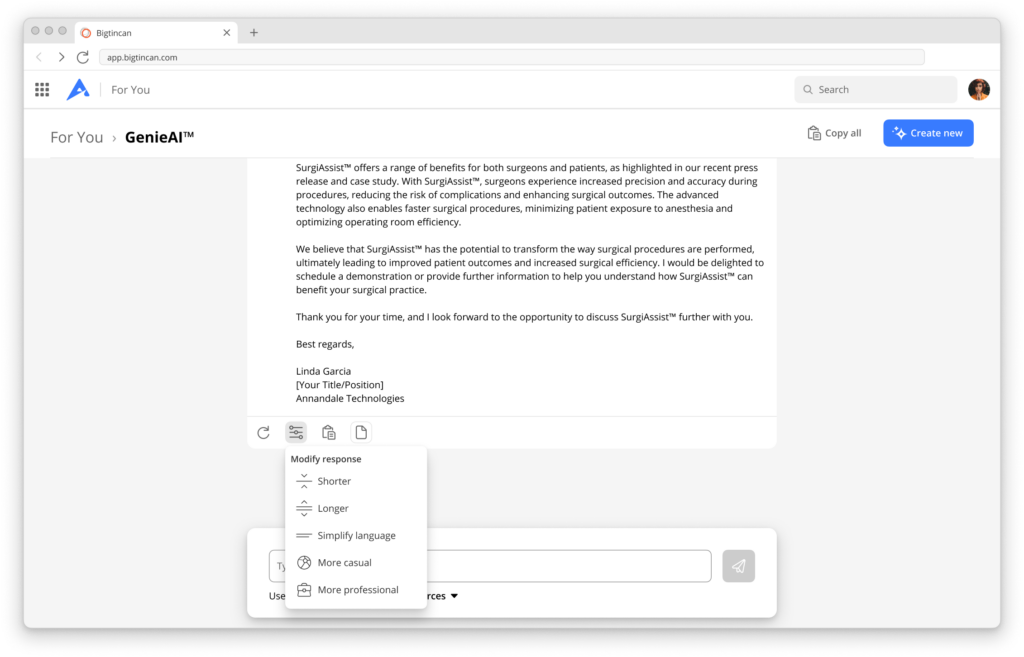
Sellers and marketers can use Generative AI to:
- Produce first drafts of emails and slide notes that act as a jumping-off point
- Generate meeting transcripts
- Get examples of outlines and frameworks for different types of content such as articles or webinar scripts
- Speed up processes and get “unstuck” during more creative tasks like writing and brainstorming
- Quickly summarize lengthy or complex documents and topics
- And more! Hop on over to LinkedIn and you’ll find endless advice posts about Generative AI tools and their proper usage. Take these with a grain of salt (like you would any AI output) and experiment for yourself with different prompts and use cases to see what’s most helpful for you.
In all cases, careful review and editing by a human are advised, and even necessary in some cases to ensure accuracy, originality, and quality outputs.
What are some examples of Generative AI tools?
ChatGPT from OpenAI is obviously the most well-known Generative AI tool, but since its swift rise in popularity it’s safe to say several hundred, if not thousands, of others have appeared — with many incorporating OpenAI’s technology..
Some other well-known and recommended Generative AI tools include:
- Perplexity AI (linked and referenced above)
- GenieAI (linked and referenced above)
- Google Bard
- Microsoft Copilot
And while there are technicalities and fine distinctions, the base functionality of Generative AI also informs many of the other AI tools on this list — which is why it’s first.
Coaching AI
What is Coaching AI?
Coaching AI is a type of automated coaching application driven by machine learning technology and artificial intelligence.
Enterprise Coaching AI applications may include AI-powered analysis and scoring, practice mode for safe practice and refinement with AI feedback, and the ability to provide objective feedback on not just what is said but how it is said.
Download the Aragon Research Globe™ for Enterprise Coaching 2024 to get a deeper understanding of the Coaching AI landscape.
How is Coaching AI used in sales and marketing?
AI coaching is used to speed up and automate the coaching process for sales reps and other employees needing feedback on their pitches and presentations without making demands on manager time, which is becoming increasingly limited due to staff cuts across industries.
Sales or enablement managers may set up a coaching challenge and have reps complete it to practice a pitch for a new product or just to brush up on messaging using AI feedback.

People in non-sales roles like marketing, product, or general managers can also use Coaching AI to practice presentations and improve their communication skills as part of leadership training.
What are some examples of Coaching AI tools?
Some sales enablement tools come equipped with Coaching capabilities supplemented with AI, including:
- Brainshark CoachingAI (a Bigtincan Learning product)
- Seismic Learning (formerly known as Lessonly)
- Showpad Coach
Voice Generation AI
What is Voice Generation AI?
From Perplexity AI:
Voice Generation AI, also known as AI Voice Generators, refers to the use of artificial intelligence to create synthetic, human-like speech from written text.
These AI tools utilize advanced algorithms, deep learning, and natural language processing to convert text into natural-sounding speech, mimicking the tonalities and prosodies of human speech.
How is Voice Generation AI used in sales and marketing?
AI Voice Generators are used in virtual assistants, chatbots, audiobooks, navigation systems, video content creation, and more.
Sales reps, marketers, enablement managers (basically anyone producing presentation or video-based training or promotional content) can use realistic AI-generated speech to auto-narrate slides, generate auto-captioning, slide notes, and translate important videos and presentations to support global team communication.
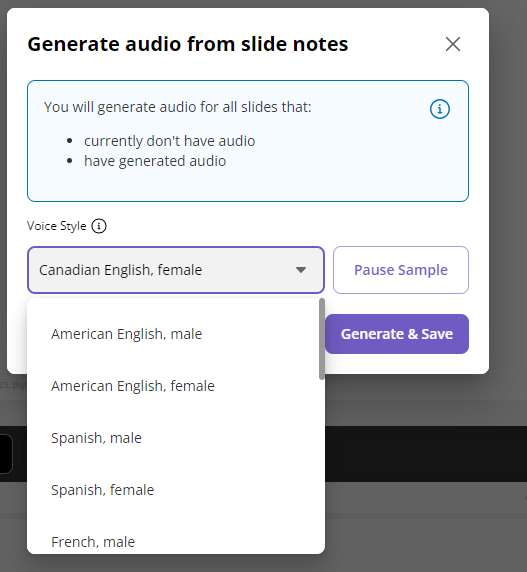
Say you’re a product marketer at an international organization creating a sales training video for a product launch. If you’re based in North America and create the script in English, Voice Generation AI lets you automatically create a translated version of your video to share with your APAC and EMEA teams.
The same applies for enablement managers supporting international teams or sales reps communicating with prospects in different countries.
What are some examples of Voice Generation AI tools?
These tools are extensive and have already proliferated our lives — think Alexa, Siri, whichever GPS app you use. Even when narrowed to a SaaS or B2B context there are a ton to choose from depending on your use case.
Brainshark has had this feature for years to allow users to quickly narrate PowerPoints (shown above) and will be releasing an even more sophisticated version in 2024 called AuthoringAI.
Others include:
Sales AI Assistants
What are Sales AI Assistants?
AI Sales Assistants are software agents that can perform tasks for individual reps based on their commands or questions.
They can help sellers by:
- Generating text for emails and other sales collateral
- Providing real-time alerts and analytics
- Offering guidance and talk tracks
- Delivering instant access to knowledge sources
- Automating the process of tracking and delivering insights on sales and training activities
How are Sales AI Assistants used in sales and marketing?
Since Generative AI capabilities inform much of what they do, AI Assistants are also primarily geared toward serving sales and other overtaxed enterprise go-to-market (GTM) functions, like marketing and enablement, who benefit from the extra “set of hands” when completing manual tasks.
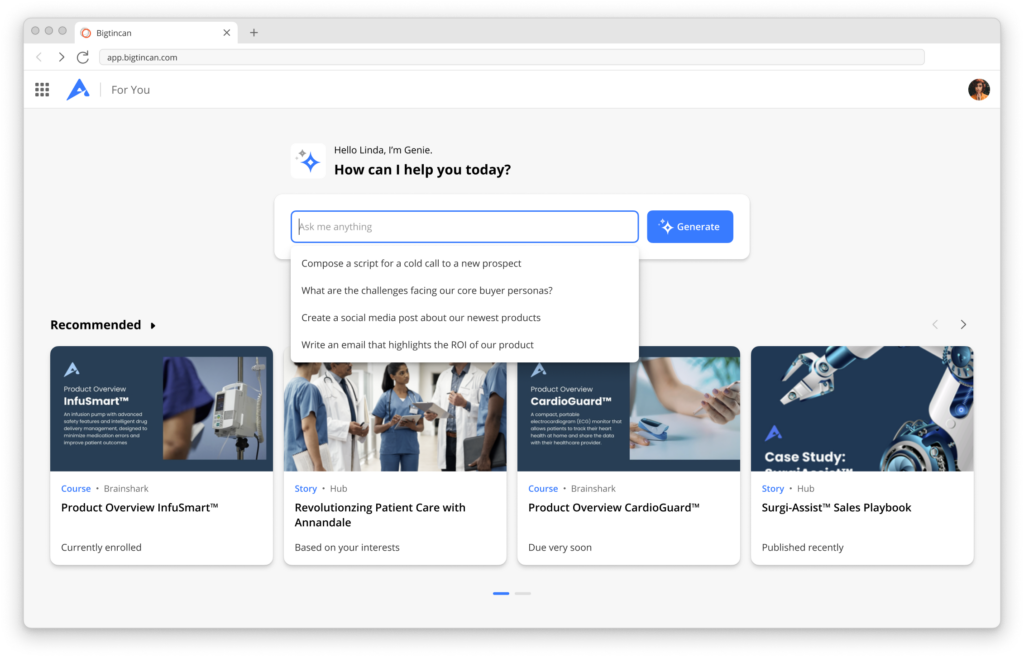
From Jim Lundy CEO and Founder of Aragon Research:
We're predicting the rise of intelligent sales assistants that become a kind of ‘front end’ for a salesperson or sales manager working with a sales enablement platform like Bigtincan by starting to perform functions for that individual.
These AI assistants don't necessarily replace that individual, but help them with manual tasks like pulling slides from disparate decks to prepare a new one or preparing an email draft.
What are some examples of Sales AI Assistant tools?
Not to be confused with personal AI Assistants like Siri or Google Assistant, Sales AI Assistants aiding GTM professionals with day-to-day business tasks include:
Chat AI
What is Chat AI?
Chat AI, also known as Chatbots, are another form of Generative AI that you can interact with in a question and answer style conversation.
This is the form of AI most people are familiar with in business contexts thanks to the popularity of ChatGPT as well as the conversational marketing and customer service bots that have been popping up (literally) on websites since the early 2010s.
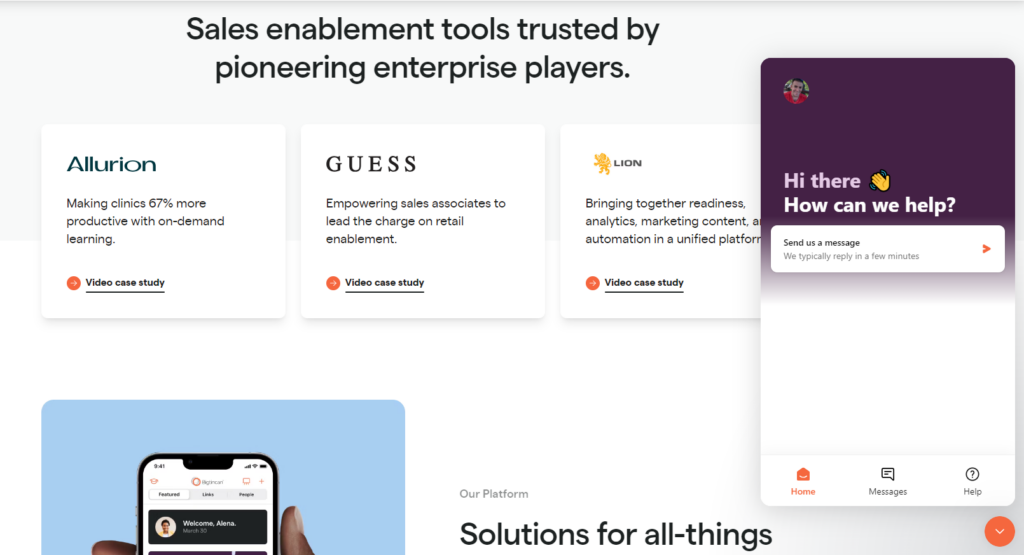
How is Chat AI used in sales and marketing?
Like Generative AI, the uses of Chat AI are numerous and broad depending on the individual user’s approach and level of ingenuity.
Sellers use Chat AI to quickly query the internet or their internal knowledge base (if using a proprietary tool) and find answers to questions ranging from “What’s a good template for an email about AI?” to “How are [prospect industry] [prospect role] using AI?”
Marketers (like the one writing this article) can use it to generate definitions (like some of the ones you see here), create frameworks for content, produce initial drafts, summarize large swaths of information, conduct research, or test copy phrasing.
Marketing, sales, and/or customer service teams may also decide to place a Chatbot on the company website to field questions during off hours, collect initial information from a prospect, or resolve simple issues.
Roleplay AI
What is Roleplay AI?
From GenieAI:
RolePlayAI is a tool that allows sales representatives to practice real-time text and audio conversations with AI in order to simulate buying scenarios.
The AI can accurately take on buyer personas and concerns, and the dialogues are ever-changing, making sellers think on their feet. It provides a safe space for reps to practice without being constrained by manager time and offers AI-graded feedback based on the selected sales methodology.
How is Roleplay AI used in sales and marketing?
Enablement and sales managers can supplement their training and coaching programs with Roleplay AI by configuring the tool for specific scenarios.
Sellers can then use it to prepare for upcoming meetings, practice their pitches, train themselves to quickly respond to unexpected questions or objections, and generally improve their performance.

Marketers may take advantage of Roleplay AI as a research tool to get into the minds of sellers and customers and understand how they can better support these conversations with content, messaging, and sales enablement efforts.
What are some examples of Roleplay AI tools?
Designed primarily with salespeople in mind, some examples include:
Predictive AI
What is Predictive AI?
From Perplexity AI:
Predictive AI uses mathematical and statistical methods, including artificial intelligence and machine learning, to identify patterns in past events and make predictions about future events.
Predictive AI has numerous use cases, including financial forecasting, fraud detection, healthcare, and marketing. It is a valuable tool for improving decision-making and business outcomes by providing insights and recommendations based on historical data patterns.
How is Predictive AI used in sales and marketing?
People in sales and marketing roles use Predictive AI to analyze historical data about their company and customers, identify behavioral patterns, and make predictions about future deals in order to shape their strategies to enable best outcomes.
Sellers, sales managers, enablement managers, CROs, and CFOs use Predictive AI to forecast revenue and make better decisions by analyzing data such as sales conversations, buyer behavior, and customer experiences to spot patterns, generate insights, and foresee a buyer’s next move.

This helps sales teams understand winning behavior, prioritize leads, and improve the accuracy of sales forecasts.
In marketing, Predictive AI can be used to anticipate customer behavior, identify trends, and make faster, more effective decisions about content creation, how to shape and support buying journeys, and craft successful campaigns.
What are some examples of Predictive AI tools?
Like other AI tools on this list, Predictive AI tools are often part and parcel of other software applications, like business intelligence and sales enablement platforms, and are heavily geared toward revenue and deal forecasting.
Some examples include:
AI Search and Recommendations
What are AI Search and Recommendation tools?
AI Search and Recommendation tools use machine-learning algorithms and personalized behavioral data to point users to the most relevant resources.
This is the science behind search engines and “For You” pages that sometimes recommend articles, topics, and videos so accurate to your interests that it can get spooky.
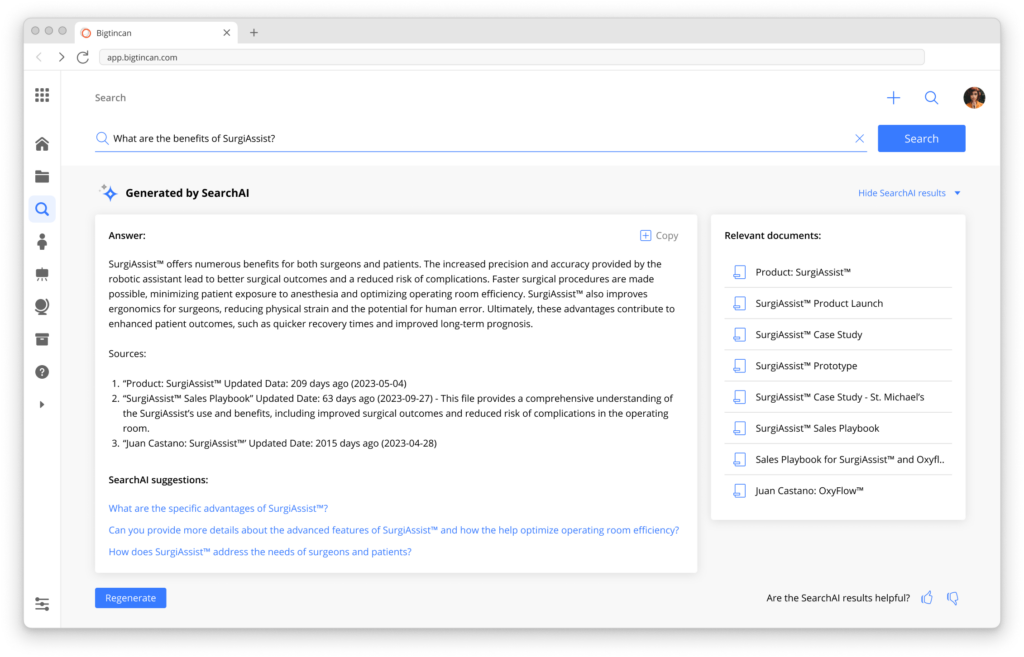
How are AI Search and Recommendation tools used in sales and marketing?
Going beyond your TikTok feed, AI Search and Recommendation tools are important in sales enablement contexts because enterprise go-to-market organizations create a TON of content. It builds up quickly over time, creating a confusing and overwhelming situation for sellers in particular, who need to find specific content for customers under tight deadlines.
AI Search and Recommendations provide the best content for specific sales situations and to recommend the best content for the right context. The AI model identifies the most relevant information to suit specific needs, and the system dynamically updates itself based on the content it has access to and details from the CRM.
This is true for both internal learning and external sales enablement content, which aids marketing and enablement efforts by increasing seller adoption of content they create.
What are some examples of AI Search and Recommendation tools?
This is another category that can quickly get muddy and overwhelming because of the sheer quantity of tools that have become common in almost every aspect of daily life, whether it’s personal or for business. Think Google. Instagram. Bing. Anywhere you’re typing into a search bar or trying to find content.
But these capabilities are also built into specialized applications like sales enablement platforms that are designed for enterprise content management, like Bigtincan, Seismic (linked above), Allego, or any of the players in this space.
Meeting AI
What is Meeting AI?
Meeting AI refers to the integration of artificial intelligence into business meetings and all of the processes surrounding them — preparation, execution, and follow-up.
Depending on the tool, it can encompass various AI-powered features such as automatic AI-generated summaries, conversation intelligence, auto-logging to CRM, and holistic content and engagement analytics.
It can also include capabilities like AI-generated slide notes, translation, and voice cloning via Voice Generation AI.
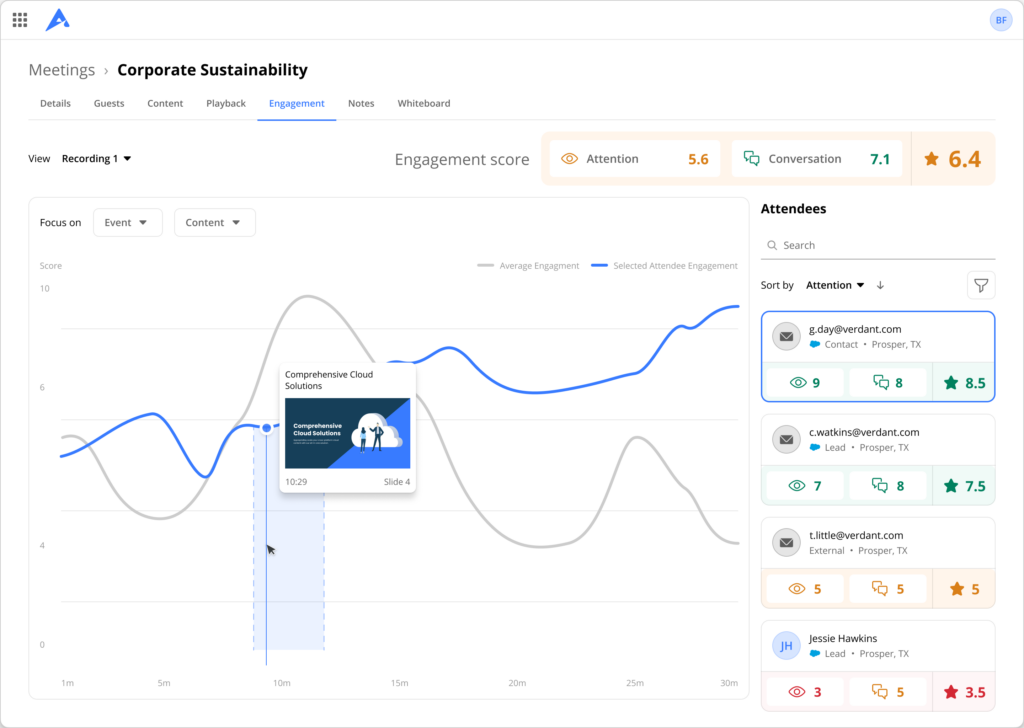
How is Meeting AI used in sales and marketing?
At a base level, half of AI is about automation. It's not about intelligence. It's about automating processes. And again, salespeople have to do an awful lot of manual things to get a deal done.
- Jim Lundy CEO and Founder of Aragon Research
Meetings are one of the most important drivers of sales, and they require a ton of investment from sellers, enablement managers, and marketers to pull off successfully.
Meeting “side work” typically includes:
- Training and coaching reps so they show up prepared
- Creating and customizing the slides and slide notes
- Writing scripts and messaging to make sure they’re relevant, personalized, and engaging
- Monitoring attendees’ engagement and interest during the meeting
- Reviewing the transcript and/or recording of the meeting
- Logging notes to the Salesforce or other CRM so account data is accurate
- Pulling the most important insights from the meeting to determine next steps
- Following up with the customer in a meaningful way and in a timely manner
And many of these are tasks Meeting AI can assist sellers and marketers with, whether it’s tracking which content performs the best during your sessions, auto-generating meeting summaries, or even drafting follow-up emails based on the content of the conversation.
What are some examples of Meeting AI tools?
Conversation AI
What is Conversation AI?
Conversation AI, also called Conversation Intelligence, transcribes and reviews recorded sales calls to provide AI-driven objective analysis of the conversation.
The AI provides feedback on things like percentage of participant time spent speaking, total questions asked, conversation switches, speaker articulation feedback, and tone-of-voice analytics, depending on the tool you use.
How is Conversation AI used in sales and marketing?
Conversation AI or Conversation Intelligence (CI) allows sales managers to quickly uncover coachable moments through AI-generated conversation, articulation, and tone of voice insights, and share best practice example videos across the team.
It also helps individual sales reps understand how they’re being perceived and how they compare to high performers so they can self-coach and improve their communication skills.

For example — the Conversation analysis will show sellers if they spoke more than the customer, interrupted them, came off as arrogant, ignored any questions, and so on. Sellers can take these insights from the AI as areas of improvement and work on them with their coach, manager, or enablement team so they do better on future calls.
See: What vibes help you sell? How AI-powered sales coaching improves your pitch
CI tools also create libraries of sales calls over time which can serve as a treasure trove of information for marketers conducting customer research. Marketers can search transcripts for keywords to see how customers feel about certain topics or which questions they asked, then create content and messaging for those topics so it's relevant to their audience and sales workflows.
What are some examples of Conversation AI tools?
There are still some standalone CI products, but many have been acquired and embedded in sales enablement suites as market trends move toward complete platforms and away from “sales tool overload.”
- Gong (linked above)
- Chorus by ZoomInfo
- VoiceVibes by Bigtincan
Was this helpful? Follow us on LinkedIn for more insights and browse through some of our other resources on AI tools for sales and marketing teams, like this new report from Sales Mastery and those linked below.
